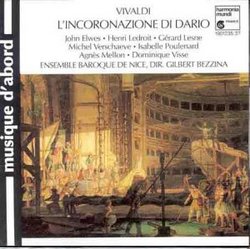| All Artists: Antonio Vivaldi, Gilbert Bezzina, Ensemble Baroque De Nice, John Elwes, Gérard Lesne, Henri Ledroit, Michel Verschaeve, Isabelle Poulenard, Agnès Mellon, Dominique Visse Title: Vivaldi - L'incoronazione di Dario / Elwes · Ledroit · Lense · Verschaeve · Poulenard · Mellon · Visse · Bezzina Members Wishing: 0 Total Copies: 0 Label: Harmonia Mundi / Hmf Musique D'abord Release Date: 5/9/1997 Album Type: Import Genre: Classical Styles: Opera & Classical Vocal, Historical Periods, Baroque (c.1600-1750) Number of Discs: 3 SwapaCD Credits: 3 UPC: 794881374625 |
Search - Antonio Vivaldi, Gilbert Bezzina, Ensemble Baroque De Nice :: Vivaldi - L'incoronazione di Dario / Elwes · Ledroit · Lense · Verschaeve · Poulenard · Mellon · Visse · Bezzina
 | Antonio Vivaldi, Gilbert Bezzina, Ensemble Baroque De Nice Vivaldi - L'incoronazione di Dario / Elwes · Ledroit · Lense · Verschaeve · Poulenard · Mellon · Visse · Bezzina Genre: Classical
|
Larger Image |
CD Details |
CD ReviewsOld School Approach to Young Vivaldi A. Mazon | 02/12/2010 (5 out of 5 stars) "This opera dates from very early on in Vivaldi's career, so it is a sort of a transition work between a developing composer incorporating the forms and musical language around him, and the mature Vivaldi with his distinct harmonic and rhythmic style. The libretto also harks back to an earlier period, with its long stretches of rectitative, the varying structure of the arias and the use of comic characters within a serious work. Finally, this particular recording was made in 1986, the earlier days of the "Historically Informed Performance" movement, yet does not suffer from some of the more overtly "academic", dry interpretations of that period.
None of this should dissuade potential listeners used to contemporary conductors such as Alessandrini, Spinosi or Sardelli recording some of Vivaldi's later, more mature operas such "L'Olimpiade" or the Orlando operas. It's simply a different animal, and in our own contemporary recording context it is a refreshing change of pace. For starters, the Ensemble Baroque de Nice plays with a much thicker sound, in orchestral passages as well as in continuo accompaniments in the recitatives. It's definitely a "period instrument" sound, but the larger orchestra and more voluminous texture of the strings and continuo (with booming bass lines handled by bassoon) are a contrast to more incisive, scrappier timbres of more recent groups. In addition, everything is handled at a much more gradual clip, and the relaxed (but never crawling) tempos allow improved pronunciation of the words and more room to show off the beautiful sounds of the singers, orchestra and occasional instrumental soloist (such as the rich, grainy gamba solo that starts Act I's final aria). This approach is particularly illuminating in the recitatives: proof positive that recitatives can still be music and not just monotone expressions of half-sung dialog. The cast of mezzos, sopranos countertenors and tenors is uniformly excellent, blessed with clear, lyrical voices. Though the booklet does NOT provide an English translation of the Italian libretto (only English paraphrases of the action), Italian speakers can understand the words through the singers' clear diction, and English speakers will understand the emotions and theatricality through their emotive vocal delivery. As stated, the Ensemble Baroque de Nice under Gilbert Bezzina's direction is an aural tapestry, with a lush, passionate sound that allows the listener to feel how Vivaldi uses his music to move the text along (or as a beautiful sound to simply luxuriate in). The firm, grandiose brass are sprinkled throughout, and when we start to hear Vivaldi's signature sequences and percussive rhythm the strings are particularly powerful (though not as "transparent" as some other period groups). In contrast to the faster, more visceral readings of contemporary recordings, this is a very "grand" account of a transitional stage in the composer's development. Yet a part from being a curiosity or another way to approach the music, it's simply an exciting, beautiful and productive set. Highly recommended! " |

 Track Listings (9) - Disc #1
Track Listings (9) - Disc #1